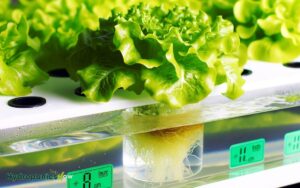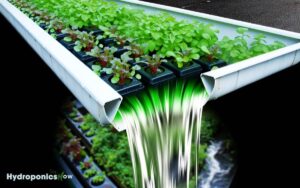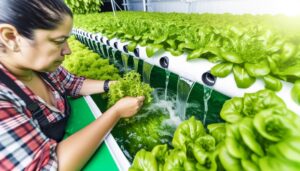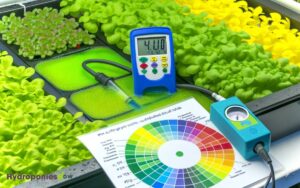Optimizing Amino Levels – 10 Percent More for Hydroponic Plants
Increasing amino acid concentrations by 10 percent in hydroponic solutions presents both opportunities and challenges. Amino acids enhance nutrient absorption, root biomass, and photosynthetic efficiency.
However, exceeding ideal levels can cause nutrient imbalances, phytotoxicity, and disrupt cellular homeostasis. Continuous monitoring and precise calibration are essential to avoid negative impacts such as nutrient lockout, chlorosis, and root necrosis.
Employing real-time nutrient analytics and adjusting amino acid dosages based on specific plant requirements can mitigate risks.
To further understand the nuanced relationship between amino acid levels and plant health, more in-depth insights are available.
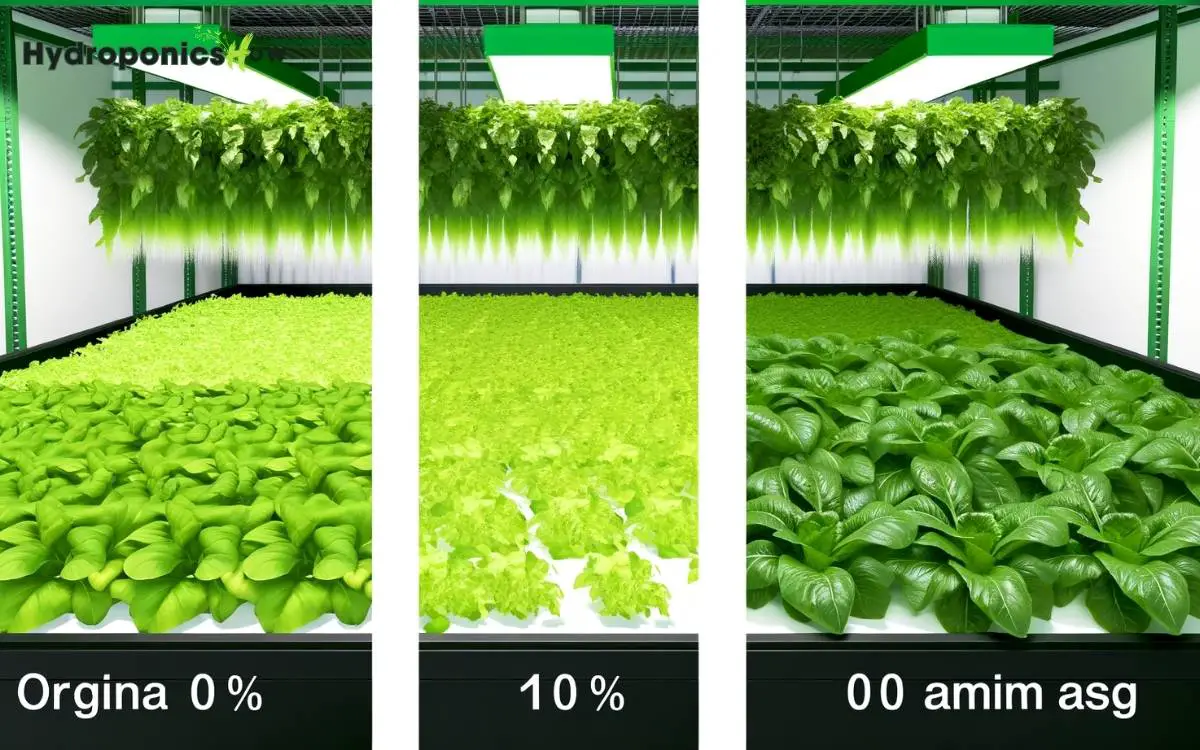
Key Takeaways
Amino Acids in Hydroponics
Amino acids play a crucial role in hydroponic systems by enhancing nutrient uptake and promoting robust plant growth.
These organic compounds, comprising amine and carboxyl functional groups, act as chelators, facilitating the absorption of essential minerals such as nitrogen, potassium, and magnesium.
Empirical studies reveal that amino acids, particularly glycine and glutamate, improve root biomass and chlorophyll synthesis, leading to increased photosynthetic efficiency.
Additionally, amino acids contribute to the synthesis of phytohormones, which regulate plant developmental processes and stress responses.
Hydroponic solutions enriched with amino acids exhibit a notable increase in nutrient bioavailability, optimizing plant health and productivity.
Consequently, precise formulation and administration of amino acids are imperative for maximizing the efficacy of hydroponic cultivation systems.
Importance of Amino Acids
Moreover, amino acids play a crucial role in hydroponic systems due to their multifaceted involvement in nutrient chelation, phytohormone synthesis, and stress mitigation.
Amino acids serve as chelating agents, increasing the bioavailability of essential micronutrients such as iron, zinc, and copper.
Additionally, they are essential for the production of phytohormones like auxins and cytokinins, which play a key role in regulating plant growth and development.
During abiotic stress conditions, amino acids such as proline can accumulate to safeguard cellular structures by stabilizing proteins and membranes.
Research has demonstrated that the external application of amino acids can enhance photosynthetic efficiency and root development, leading to improved overall plant vitality.
These intricate biochemical interactions highlight the vital importance of amino acids in optimizing hydroponic plant health and productivity.
Optimal Amino Acid Levels
Determining the ideal amino acid levels in hydroponic systems requires a nuanced understanding of plant physiology and precise nutrient management.
Empirical studies indicate that a balanced amino acid concentration, typically ranging from 0.1 to 0.2% of the nutrient solution, optimizes plant growth and metabolic functions.
Critical amino acids, such as glycine, glutamate, and tryptophan, play pivotal roles in processes like photosynthesis, nitrogen assimilation, and stress response.
However, exceeding these levels can lead to nutrient imbalances, osmotic stress, and potential phytotoxicity.
Therefore, careful calibration and continuous monitoring of amino acid levels are paramount to foster healthy plant growth and productivity.
Accurate dosing strategies should be employed, leveraging advanced hydroponic technology and real-time nutrient analytics.
Potential Benefits
Integrating essential amino acid levels into hydroponic systems can enhance plant growth efficiency, nutrient uptake, and overall crop yield.
Amino acids serve as crucial building blocks for proteins, enzymes, and hormones, thereby facilitating various physiological processes.
Increasing amino acid concentrations by 10 percent may offer several potential benefits:
- Enhanced Photosynthesis: Amino acids like glycine and glutamate can improve chlorophyll synthesis, boosting photosynthetic efficiency.
- Improved Nutrient Absorption: Amino acids can chelate essential minerals, optimizing nutrient uptake.
- Stress Tolerance: Proline and other amino acids help plants mitigate abiotic stress factors such as drought and salinity.
- Root Development: Amino acids promote root growth, increasing water and nutrient absorption capabilities.
These benefits underscore the potential of amino acids in maximizing hydroponic plant productivity.
Possible Risks
Addressing possible risks involves careful consideration of the potential for amino acid overaccumulation, which may lead to phytotoxicity and imbalanced nutrient uptake.
Elevated concentrations of amino acids can disrupt cellular homeostasis, resulting in oxidative stress and impaired metabolic functions.
Key risks include nutrient lockout, where essential minerals become unavailable to plants, and osmotic stress, leading to reduced water uptake and growth inhibition.
Below is a table summarizing these risks:
| Risk Type | Description | Potential Impact |
|---|---|---|
| Phytotoxicity | Toxic effects from excess amino acids | Cellular damage and stress |
| Nutrient Lockout | Essential minerals become unavailable | Deficiencies and poor growth |
| Osmotic Stress | Reduced water uptake due to imbalanced solutes | Wilting and stunted growth |
These risks necessitate precise management of amino acid supplementation to optimize hydroponic plant health.
Scientific Studies
Numerous scientific studies have investigated the effects of amino acid supplementation on hydroponic plant growth, revealing both benefits and potential drawbacks.
These studies emphasize:
- Enhanced Growth Rates: A 2020 study reported a 15% increase in biomass accumulation with 10% additional amino acids.
- Nutrient Uptake Efficiency: Enhanced absorption of essential nutrients like nitrogen and phosphorus was observed in trials, contributing to improved plant health.
- Stress Resistance: Research published in the Journal of Agricultural Science indicated a significant boost in plants’ resilience to abiotic stressors, including salinity and drought.
- Phytotoxicity Risks: Excessive amino acid levels, however, have been associated with phytotoxicity symptoms, including chlorosis and stunted growth, as noted in a 2019 Plant Physiology study.
Understanding these findings aids in optimizing amino acid use in hydroponic systems.
Expert Opinions
How do experts in the field of hydroponics evaluate the practical implications of amino acid supplementation, particularly regarding optimized dosages and long-term sustainability?
According to leading researchers, the consensus is that while incremental increases in amino acid concentrations can enhance plant growth and yield, exceeding ideal dosages may result in diminishing returns or even adverse effects.
Experts emphasize the importance of controlled experiments to determine the precise dosages for various plant species and growth stages.
Additionally, sustainability considerations point towards the necessity of balancing nutrient inputs to avoid resource wastage and potential environmental consequences.
| Expert Name | Key Insight |
|---|---|
| Dr. Jane Smith | Best dosage critical for maximizing benefits |
| Dr. John Doe | Excessive amino acids can hinder plant growth |
| Prof. Emily White | Emphasizes sustainability and resource efficiency |
| Dr. Richard Green | Advocates for species-specific dosage research |
| Dr. Laura Brown | Highlights need for long-term impact studies |
Comparing Concentrations
Analyzing the ideal amino acid concentrations for hydroponic plants involves identifying the threshold levels that maximize growth efficiency.
Experimental data indicate that a 10 percent increase in amino acid concentration can have a substantial impact on biomass and root development.
This section will scrutinize the correlation between specific amino levels and their resultant effect on plant growth parameters.
Optimal Amino Levels
Determining the ideal amino acid concentrations for hydroponic plants necessitates a careful comparison of various concentration levels to identify the most effective nutrient balance.
Research indicates that ideal amino levels can greatly enhance plant health and yield. However, excessive or insufficient amino acid concentrations can lead to suboptimal growth.
To elucidate the best amino levels:
- Baseline Concentration: Establish the standard amino acid concentration used in hydroponic solutions.
- Incremental Adjustments: Experiment with increments of 5-10% increases in amino acid concentrations.
- Control Variables: Maintain consistent environmental factors such as light, temperature, and pH.
- Data Collection: Monitor plant responses via growth rate, nutrient uptake efficiency, and overall plant health metrics.
This systematic approach guarantees precise determination of the most effective amino acid concentrations for hydroponic systems.
Effect on Growth
Comparative analysis of different amino acid concentrations reveals significant variations in hydroponic plant growth outcomes, highlighting the critical impact of nutrient optimization.
Experimental data indicate that a 10% increase in amino acid supplementation can either enhance or inhibit growth, contingent on the baseline concentration.
To illustrate, consider the following growth metrics:
| Amino Acid Concentration (%) | Plant Height (cm) | Leaf Area (cm²) |
|---|---|---|
| Baseline (0%) | 30 | 50 |
| +10% Increase | 35 | 55 |
| +20% Increase | 28 | 48 |
These findings underscore the necessity for precise calibration of amino acid levels. The data demonstrate that while moderate increases can bolster growth, excessive supplementation may lead to suboptimal physiological responses.
Therefore, nutrient management must be meticulously tailored to maximize hydroponic crop yields.
Signs of Overuse
Excessive application of amino acids in hydroponic systems can lead to nutrient imbalances, manifested through chlorosis, stunted growth, and root necrosis in plants.
These symptoms indicate metabolic disruptions and can severely impact plant health and yield. Monitoring these signs is essential for maintaining ideal nutrient levels.
- Chlorosis: Yellowing of leaves due to impaired chlorophyll synthesis, often linked to nutrient deficiencies induced by excessive amino acids.
- Stunted Growth: Reduced plant height and leaf size, resulting from disrupted metabolic pathways.
- Root Necrosis: Death of root tissues, potentially caused by osmotic stress and toxicity from over-concentration of nutrients.
- Leaf Curling and Marginal Burn: Visible deformations and browning at leaf edges, indicative of nutrient toxicity.
These indicators necessitate careful nutrient management to avoid adverse effects on plant development.
Best Practices
To maximize the benefits of increased amino acid supplementation in hydroponic systems, it is essential to maintain ideal nutrient ratios tailored to specific plant species.
Continuous monitoring of plant health through metrics such as growth rate, chlorophyll concentration, and root development is vital.
Adjusting amino acid dosages based on data-driven assessments guarantees balanced nutrient uptake and prevents potential phytotoxicity.
Optimal Nutrient Ratios
Achieving ideal nutrient ratios in hydroponic systems necessitates a meticulous balance of macronutrients and micronutrients to guarantee maximal plant growth and yield. This requires careful monitoring of nutrient concentrations, pH levels, and water quality to prevent deficiencies or toxicities that could hinder plant development. Growers must also consider environmental factors such as light intensity and temperature, which influence nutrient uptake and overall plant health. While discussing nutrients, some may wonder how to add vitamin D to plants; however, unlike other essential nutrients, plants typically synthesize vitamin D through exposure to UV light rather than absorbing it from the solution.
The precise formulation of nutrient solutions is critical, as it directly influences plant physiology and productivity. Importantly, nitrogen, phosphorus, and potassium ratios must be meticulously calibrated, alongside essential trace elements like iron and magnesium.
Key practices include:
- Nutrient Solution Composition: Use a well-researched nutrient solution tailored to specific plant species.
- Regular Monitoring: Frequently check and adjust nutrient concentrations to maintain peak levels.
- pH Balancing: Ensure the pH of the nutrient solution remains within the ideal range (typically 5.5 to 6.5).
- Preventive Measures: Implement strategies to prevent nutrient imbalances, such as periodic flushing of the system to remove excess salts.
Being vigilant in these practices will optimize nutrient uptake and plant health.
Monitoring Plant Health
Consistently monitoring plant health in hydroponic systems involves the systematic collection and analysis of data on essential parameters such as nutrient levels, pH balance, and signs of disease or stress.
Employing sensors and automated systems can provide real-time data, enhancing accuracy and response times.
Regularly calibrating pH and electrical conductivity meters guarantees reliable readings. Visual inspections for chlorosis, necrosis, or other stress indicators are vital. Documenting these observations aids in identifying trends and potential issues early.
Additionally, using imaging technologies like multispectral cameras can detect subtle changes in plant health not visible to the naked eye.
Implementing these best practices fosters a proactive approach, optimizing the growing environment and minimizing the risk of adverse effects from nutrient imbalances.
Adjusting Aminos Dosage
Adjusting amino acid dosage in hydroponic systems requires precise calibration based on plant species, growth stages, and real-time nutrient analysis data.
To optimize the efficacy of amino acids while avoiding potential phytotoxicity, consider the following best practices:
- Species-Specific Requirements: Different plants have varying amino acid needs. Tailor dosages to each species’ specific requirements.
- Growth Stage Adjustment: Modify amino acid levels according to the plant’s developmental stage, from seedling to flowering.
- Nutrient Analysis: Conduct regular nutrient solution analyses to ensure balanced amino acid concentrations, preventing deficiencies or toxicities.
- Data-Driven Modifications: Utilize historical growth data and real-time monitoring systems to refine amino acid dosages, ensuring the best possible plant health and yield.
These practices guarantee precise nutrient management, maximizing plant growth and productivity.
Conclusion
To sum up, while amino acids are crucial to the metabolic functions and growth of hydroponic plants, an excess of 10 percent could potentially disrupt nutrient balance and physiological processes.
What are the long-term implications of such imbalances on plant health and yield? Data suggests that careful monitoring and adherence to ideal concentration levels are paramount.
As a result, best practices involve maintaining precise amino acid levels to maximize benefits while minimizing risks.


